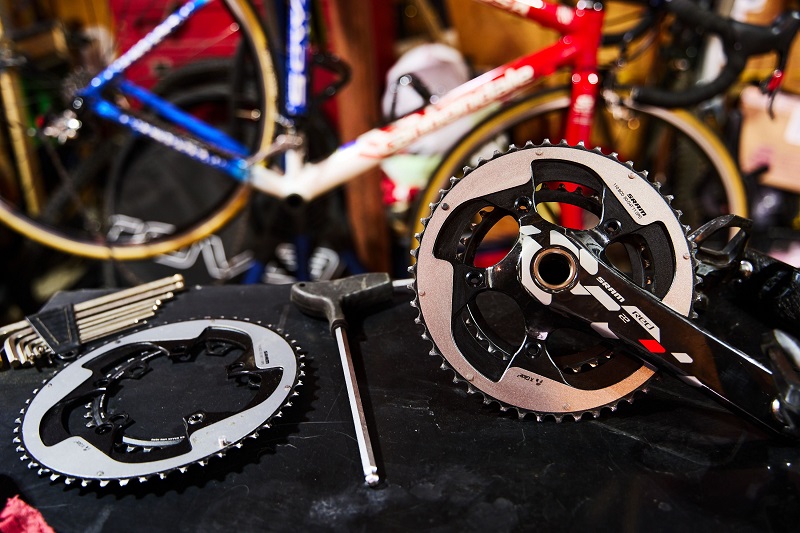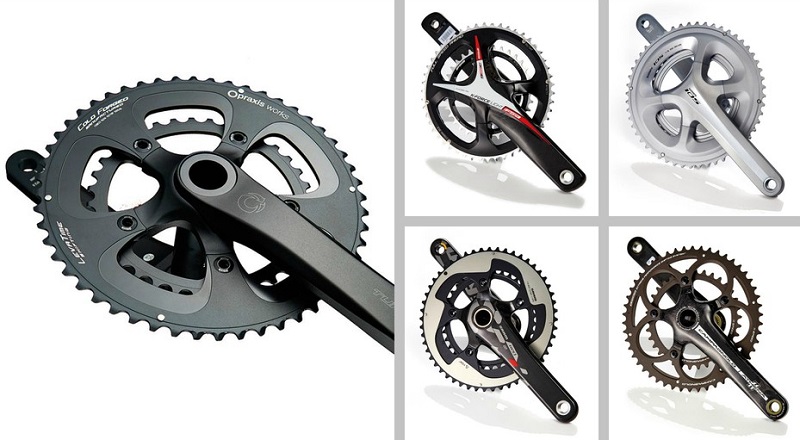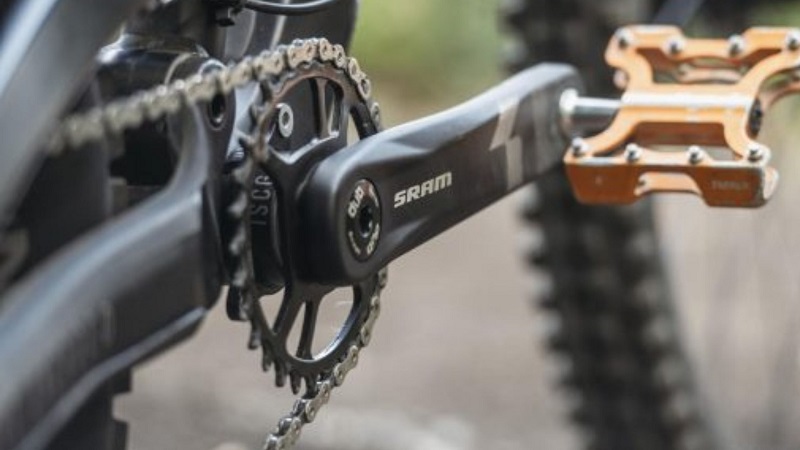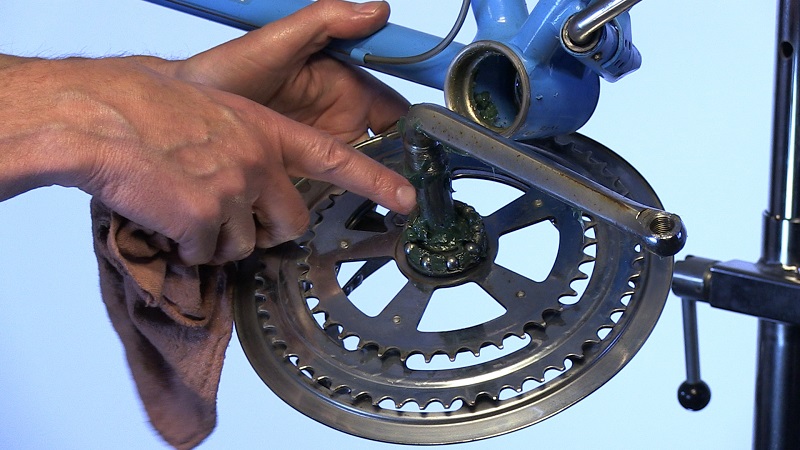Parts
Bike Cranksets Explained: Everything You Need To Know
When it comes to cycling, one of the most critical components of your bike is the crankset. A high-quality crankset can significantly impact your cycling performance, making it crucial to understand the intricacies of this essential part. In this article, HookBike’s will delve deep into Bike cranksets, providing you with everything you need to know to make an informed decision and enhance your cycling experience.
What Is a Bike Crankset?
A bike crankset, also known simply as a “crank,” is the component of a bicycle’s drivetrain that connects the pedals to the chainrings, which in turn drive the chain and rotate the rear wheel. It plays a crucial role in transferring human pedaling power to the bike’s wheels.

A standard crankset typically consists of the following components:
- Crank Arms: These are the two long, lever-like arms that extend from the bottom bracket (the axle that connects to the bicycle frame) to which the pedals are attached.
- Chainrings: These are the toothed, circular discs that are mounted to the crank arms. They engage with the bicycle chain, transferring power from the rider’s pedaling motion to the chain.
- Cranksets come in various configurations, including single, double, and triple chainring setups, with the number of chainrings determining the number of available gears. Some common types of crankset configurations include:
- Single: A single chainring setup is common on many mountain bikes and some road bikes. It offers simplicity and reduced weight but has a more limited range of gears.
- Double: This configuration consists of two chainrings and is found on a wide range of road and mountain bikes. It provides a broader range of gear ratios for various riding conditions.
- Triple: Triple cranksets have three chainrings and are less common on modern bikes. They offer the most extensive gear range, suitable for touring and long-distance riding.

Cranksets are available in various materials, including aluminum, steel, and carbon fiber, with each material offering different weight and stiffness characteristics. The length of the crank arms can also vary, with longer cranks potentially providing more leverage but requiring more effort to pedal.
Choosing the right crankset depends on the type of riding you intend to do, your fitness level, and your personal preferences. Different cranksets can affect your bike’s gearing, which, in turn, affects your riding experience in terms of speed, cadence, and efficiency.
Types of Bicycle Crank
Bicycle cranks come in various types and configurations to suit different riding styles and disciplines. Here are some common types of bicycle cranks:
- Standard Double Crankset: This is the most common type of crankset found on road bikes. It consists of two chainrings (usually with tooth counts like 53/39 or 50/34) and is designed for a wide range of riding conditions.
- Compact Double Crankset: Also known as a “compact crankset,” it features two chainrings with smaller tooth counts (typically 50/34 or 48/32). This configuration provides lower gearing, making it easier to climb hills and is popular among road cyclists who encounter steep terrain.
- Triple Crankset: A triple crankset has three chainrings and is often found on touring or mountain bikes. The additional chainring provides a wider range of gear ratios, making it suitable for loaded touring or off-road riding.
- Single Speed Crankset: Single-speed cranksets have a single chainring and are typically used on single-speed or fixed-gear bikes. They are simple, lightweight, and provide a single gear ratio.
- 1x (One-By) Crankset: The 1x crankset has become popular in mountain biking and gravel riding. It features a single chainring and is paired with a wide-range cassette in the rear, often with 10-12 speeds. The simplicity of a 1x drivetrain reduces complexity and the risk of dropped chains while offering a wide gear range.
- E-Bike Crankset: Electric bicycles (e-bikes) often come with specialized cranksets designed to accommodate the motor and provide efficient power transfer. These cranksets may have specific chainring designs and sizes optimized for e-bike use.
- BMX Crankset: BMX bikes typically have a compact, sturdy crankset designed for the demands of BMX racing and tricks. BMX cranksets are usually single-speed and come in various lengths.
- Track Crankset: Track bikes, designed for velodrome racing, have unique cranksets that often don’t have a freewheel or brakes. They are optimized for high-speed racing on a closed track.
- Tandem Crankset: Tandem bicycles have cranksets designed to handle the additional torque produced by two riders. These cranksets are reinforced and may include special features like eccentric bottom brackets for fine-tuning timing chain tension.
- Fat Bike Crankset: Fat bikes, with their oversized tires for riding on sand and snow, often use cranksets with wider chainline spacing to accommodate the wide bottom bracket shell and tire clearance.
The choice of crankset type depends on your riding style, terrain, and personal preferences. Your fitness level and the type of riding you plan to do, whether it’s road cycling, mountain biking, commuting, touring, or other disciplines, will influence the crankset configuration that’s most suitable for you. Additionally, some specialized disciplines like downhill mountain biking or bikepacking may have unique crankset requirements.

Choosing the Right Crankset
Selecting the ideal crankset for your bike is crucial, as it can significantly affect your riding experience. Here are some factors to consider when making your decision:
Riding Style
Your riding style plays a vital role in determining the type of crankset you need. If you’re into long-distance road cycling, a standard crankset might be your best choice. However, if you frequently conquer steep hills or enjoy off-road adventures, a compact or triple crankset may be more suitable.
Gear Ratios
The number of teeth on the chainrings determines the gear ratios of your crankset. A crankset with a larger chainring will provide a higher gear ratio, ideal for flat and fast terrains. In contrast, a smaller chainring offers lower gear ratios, which are perfect for climbing.
Bottom Bracket Compatibility
Ensure that the crankset you choose is compatible with your bike’s bottom bracket. The bottom bracket connects the crankset to the frame and varies in types, such as threaded, press-fit, or BB30.
Material and Weight
Cranksets come in various materials, including aluminum, carbon fiber, and steel. The choice of material affects the crankset’s weight, durability, and stiffness. Consider your budget and preferences when selecting the material.

Installing and Maintaining Your Crankset
Proper installation and maintenance are crucial to ensure the longevity and performance of your crankset. Here are the basic steps for installing and maintaining your crankset:
Installation
- Start by removing the old crankset if you’re replacing it.
- Grease the threads of the bottom bracket.
- Attach the new crankset’s crank arms to the bottom bracket spindle.
- Tighten the crank arm bolts to the manufacturer’s recommended torque specifications.
Maintenance
- Regularly clean your crankset to prevent dirt and grime buildup.
- Check for loose bolts or any signs of wear and tear.
- Lubricate the chainrings and pedal threads to minimize friction and prevent corrosion.
- If you notice any unusual noises or performance issues, consult a professional bike mechanic.

Troubleshooting Common Issues
Cranksets, like any bike component, can encounter issues over time. Here are some common problems and their solutions:
Chainring Wear
Over time, chainrings can wear out, leading to poor shifting and performance. Replace the chainrings as needed to maintain optimal performance.
Loose Crank Arms
If you experience wobbling or creaking in your crank arms, it may be due to loose bolts. Tighten them to the recommended torque to resolve the issue.
Bottom Bracket Noise
Unusual noises from the bottom bracket area may indicate a worn-out or damaged bottom bracket. Consult a professional mechanic to inspect and replace it if necessary.

Upgrading Your Crankset
Upgrading your crankset can be a game-changer for your cycling experience. Here are a few reasons you might consider upgrading:
- Improved Performance: Upgrading to a lighter and stiffer crankset can enhance your pedaling efficiency and overall performance.
- Weight Reduction: If you’re aiming to shed some weight from your bike, a high-quality, lightweight crankset is an excellent place to start.
- Personalization: You can choose a crankset that suits your riding style and aesthetic preferences.
- Compatibility: Upgrading your crankset can also be an opportunity to improve compatibility with other drivetrain components.
Conclusion
In conclusion, your bike’s crankset is a fundamental component that directly influences your cycling experience. Understanding the types of cranksets, choosing the right one for your riding style, proper installation, and regular maintenance are key to maximizing the lifespan and performance of your crankset.
Whether you’re a dedicated road cyclist or a mountain biking enthusiast, having a well-maintained and suitable crankset is essential for an enjoyable and efficient ride. By following the guidelines provided in this article, you can make an informed decision when selecting, installing, and maintaining your bike’s crankset, ensuring many miles of smooth and enjoyable cycling ahead.

